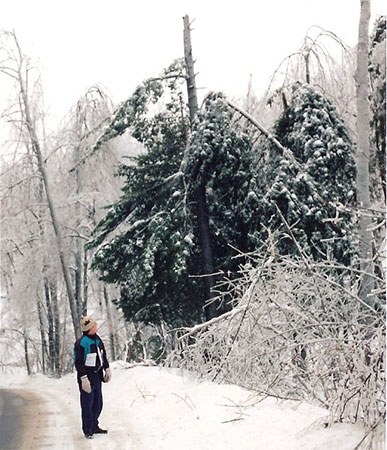Forest renewal after Ice Storm of ’98

Damaged trees along Notch Road in Gatineau Park during the Ice Storm of ’98. Photo: Deb, Creative Commons, some rights reserved
Anyone living in this region at the time recalls the Ice Storm of ’98. Matter of fact, most don’t even attach the year, just saying “the ice storm” is enough. (We arrived in ’99, so I missed it.)
Carleton University Geography professor Doug King and PhD student Evan Seed spent years studying the effects of that event on Quebec’s Gatineau Park. As reported by Tom Spears for the Ottawa Citizen, the story is mostly one of renewal:
Gatineau Park has bounced back from the 1998 ice storm but with subtle differences still apparent all these years later, and with a message.
Damaging ice storms are a normal part of the life-and-death cycle of our forests, just as forest fires are much farther north.
That may sound like an unremarkable conclusion. But the severity of the ice storm was such that it does warrant study. Spears’ article lists more observations and conclusions, if you’d like specifics. Study conclusions were presented in association with the 75th anniversary of Gatineau Park’s creation.
As part of Research Month events there (Nov 16, 23 and 30) King and Seed will present a talk about their study (in English) at 2 pm Saturday at the Visitors Centre in Chelsea.
Many In Box readers are aware of how the Ice Storm affected forests where they live. Please do share comments and observations below.
Tags: canada, environment, forestry, Gatineau Park, Ice Storm of 1998, science






.jpg)

it was the main reason I logged 40 acres the following fall
It pushed back me starting up classes at clarkson by three whole days! the drive back to school that semester was quite surreal. SUNY potsdam was pushed back longer since it was a staging area for utility trucks. I never saw so many trucks lined up, idling in my life. Quite an operation.
“Damaging ice storms are a normal part of the life-and-death cycle of our forests, just as forest fires are much farther north.”
Do they mean “farther west”?
One area near here that never recovered was through the cascade lake area? Those birch trees never came back and probably never will. Other places have some subtle things you can still see. Forest growth must still be impacted. I wonder if the deformed trees, which now look pretty normal have normal growth characteristics?
“I never saw so many trucks lined up, idling in my life. Quite an operation.”
Probably the type of thing you see as a hurricane approaches coastal towns. Was leaving South Carolia once when a hurricane was approaching Florida. The southbound lane of I95 was a solid line of utility trucks! Wild. I hear what you mean. I think I was in Boston at the time and didn’t get a chance to see this until some of the aftermath was cleared.
Interestingly I think that this storm may have had a major impact on deer mortality that year. That year seems to have marked the point of decline in the Whitetail population in areas of the Adirondacks between Saranac Lake and the St. Lawrence Valley. That area (I know that other areas have good deer hunting so it isn’t a phenomena that is across the Adirondacks) went from numerous deer before that to very few after that. I am curious if this has been looked into. It is a phenomena that I have heard of from all the hunting clubs in that area and that year is a clear mark. There was a decline following the deer feeding ban of 1993 (many clubs fed in these areas) but there was a more severe drop in 1998. Anyone?
I shouldn’t say “all” but lots.
I remember my friends up north saying that during the storm, the hockey arena at Clarkson was the only place in Potsdam WITHOUT ice.
(It was being used as a shelter)
paul, the trees I left, most all since recovered do have altered crown growth characteristics.
blow down from the change in the forest top occurred quite a bit for a couple years until the weather and canopy came to a new arrangement…
The ice storm of ’98 was not the only big icy event in the region in the 90’s. The ’98 event was larger geographically. I remember the reports of farmers destroying dairy herds near Montreal. Down here I saw stands that had been recently thinned turned into a forest of sleigh runners. A lot has since been salvaged. If deer populations are excessive (shoot more does), competing vegetation-fern & beech- is heavy, it is difficult to bring on a new mixed forest. I’ve seen trees 50-60 years after an ice storm and the tops are obvious if one knows what they are looking at. Crop insurance for forests is not popular.
Even old trees can take advantage of extra sunlight and stunted trees can take off and optimize the space.